Graduate Student Dipterists
Kevin Cornell Holston
M.Sc. 1999; Ph.D 2003; postdoc Swedish Museum of Natural History

Kevin Holston began his research assistantship on May 4, 1996, and started graduate school in the Department of Entomology at the University of Illinois Urbana-Champaign in the fall of 1996. He has a B.S. degree in biology from the University of Texas, Austin.
Kevin Holston became interested in robberflies (Diptera: Asilidae) after conducting ethological studies in Austin, supervised by Dr. C. Riley Nelson. He then spent several months as an intern at the Smithsonian Institution working on developing a morphologically based classification of Efferia under the direction of Wayne Mathis and F. Christian Thompson.
Mr. Holston is working on the revision of the genus Thereva, which includes species found in several zoogeographical regions. He has participated in the Summer 1996 collecting trip to the Southwestern US, in the Fall 1996 trip to South Africa, and in 1997 trips to Guatemala, Texas, and California. In 2000, he traveled to the Canadian National Collection to look at types of the genusThereva; to Washington state and Michigan to try to collect material for molecular studies in the lab of Brian Wiegmann at North Carolina State University in the spring of 2001; to Spain and Greece in late May/early June; and to Europe starting in August to collect and visit museums. He was awarded a grant from the American-Scandinavian Foundation to conduct Ph.D.-directed research in entomology at the University of Copenhagen between October and December 2000.
Kevin Holston completed the last of the required Entomology courses in December 1998. He is expanding his background in foreign languages, specifically German, which will aid in his survey of taxonomic and systematic literature related to this project.
He has focused considerable attention on nomenclature challenges presented by the genus Thereva, by finding and compiling all species names used in combination with Thereva. He is working closely with F. C. Thompson (PEET consultant) and G. E. Kampmeier (PEET collaborator) to develop the Systematic Database of Thereva Names. Under the guidance of Thompson, Mr. Holston spent a week in January 1998 going through literature to develop and improve the database of Thereva names and their associated references. Data acquisition for this project constituted the major part of a Masters thesis conferred to Kevin Holston in May 1999. Mr. Holston has worked extensively with Kampmeier on the NAMES file of the therevid database system, MANDALA, to improve its ability to handle nomenclatural concerns. The database will be published on CD-ROM in The Diptera Data Dissemination Disk, Vol. 2 of the North American Dipterists Society in 2000. It includes classification and distribution information relevant to each name as well as an extensive datafile of all literature citations.
Mark Metz
Ph.D 2002; postdoc University of Illinois 2002; postdoc Pennsylvania State University
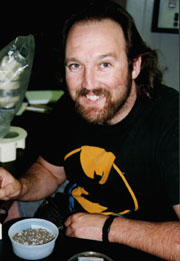
Mark Metz began his research assistantship on April 1, 1996, at the University of Illinois Urbana-Champaign. He has a M.S. degree in biology from California State University at Northridge. His M.S. thesis focused on abdominal color variation in syrphid flies and its possible connection with mimicry. He spent several months at the Smithsonian Institution entering their syrphid collection into a database under the direction of F. Christian Thompson. Mr. Metz continues his interest in syrphid flies and has just recently published a joint paper with F. Christian Thompson, “A revision of the larger species of Toxomerus (Diptera: Syrphidae) with description of a new species.” in Studia Dipterologica 8(1) 225-256 (abstract).
Mr. Metz finished course requirements for a Ph.D. in the Department of Entomology at UIUC and has supplemented his curriculum with coursework ranging in subjects from evolutionary ecology to mathematical modeling. He advanced to Ph.D. candidacy by passing his oral examinations in the Department of Entomology, but transferred to the Department of Natural Resources and Environmental Sciences where he expects to obtain his Ph.D. degree by spring 2002.
Informal aspects of training have included, but have not been limited to, field collecting techniques, insect identification, grant proposal composition, and meeting presentation and organization skills. Computer skills have been emphasized and both coursework and on hand experience in databasing, GIS, HTML construction, and other basic computer programs have been acquired. In addition, Mr. Metz has translated over 50 species descriptions from the original German and Latin texts and is improving his proficiency in German by taking coursework at UIUC.
Mr. Metz’ first therevid publication with Irwin as co-author, “Revision of Lindneria Kröber, with the Description of Two New Genera Insulatitan and Ambradolon, a Fossil from Dominican Amber (Diptera: Therevidae:Therevinae)” was published in September 2000 in the Annals of the Entomological Society of America, 93(5): 977-1018. In this paper, Metz & Irwin diagnosed a new genus of Therevidae from Dominican amber. Cladistic analysis of the species possessing putative synapomorphies with the fossil resolved three additional monophyletic therevid genera. Overall, the revision introduced two new genera, eleven new species and a new combination to science. Metz and Irwin’s second article, “Microtrombidiid mite parasitization frequencies and attachment site preferences on brachyceran Diptera with specific reference to Therevidae (Asiloidea) and Tachinidae (Oestroidea)” is scheduled to be published in the October 2001 issue of Environmental Entomology.
Mr. Metz continues research on the relationship of male and female Ozodiceromyia nanella (Cole) genitalia. He has two years of data on a population from a site in New Mexico and wrote two small proposals to continue this work in 1998. Mr. Metz also initiated the study of the association of the families of Diptera with parasitic mites from the same site in New Mexico.
For his Ph.D dissertation, Mark is revising the higher therevine genera. Some monophyletic units within the fly family, Therevidae, await characterization using modern phylogenetic techniques. Putative synapomorphies have been suggested for the two described subfamilies, Phycinae and Therevinae, but the relationships of the genera have not been determined cladistically. The higher Therevinae consist of 55+ described and manuscript genera from every biotic region. An establishment of monophyletic groups using modern cladistic techniques will more easily enable future generic revisions within this poorly known family. Currently, his dissertation study continues to expand as the relationships between therevid subfamilies remains unresolved, disallowing any monophyly on which to base a subfamilial analysis.
In the summer of 2000, Mr. Metz was a teaching associate and guest lecturer in the general entomology course (Ent 301) with Dr. Samuel Beshers. Mark won an award for his teaching by being nominated by his students for the partial list of teachers regarded as outstanding for the summer term.
Shaun Winterton
M.Sc. 1997; Ph.D. 2000; post-doc NCSU

After graduating from the University of Southern Queensland in 1992, Shaun spent the last three and a half years with the Cooperative Research Centre for Tropical Pest Management and CSIRO, researching insect-plant interactions of introduced water weeds. His taxonomic interests have been on Australian Neuroptera and he has published studies on the taxonomy and ecology of the Chrysopidae and Hemerobiidae. In July 1996, Shaun started a Graduate Diploma in Entomology with the University of Queensland, monographing [a new Australian genus] Winterton & Irwin (in press), for which he was conferred his Post-Graduate Diploma in Science (Entomology) in July 1997. In August 1997, he began a Ph.D. under Dr. David Yeates and Dr. Michael Irwin, monographing the endemic Australian genus Agapophytus (Diptera: Therevidae).
As part of his Ph.D., and in collaboration with Mr. Stephen Gaimari and Co-PI’s David Yeates and Michael Irwin, Mr. Shaun Winterton has proposed a standardized terminology for body vestiture and male genitalia. The former developed using scanning electron microscopy facilities at the University of Queensland. This terminology will be adopted in all monographs produced by the therevid group.
In collaboration with Dr. David Merritt and Anthony O’Toole (University of Queensland), Mr. Shaun Winterton, Co-PI David Yeates and Co-PI Michael Irwin have made detailed studies into the morphology and histology of a novel structure in the female therevid reproductive system. The studies include histological sections of virgin and mated females to determine the possible function of this structure.
Also in collaboration with Mr. Anthony O’Toole, Mr. Shaun Winterton and Co-PI David Yeates have begun to accumulate a photographic library of live therevids collected from the field. One of these photographs (of an undescribed genus and species) won first prize in the photographic competition at the 1997 AGM of the Australian Entomological Society in September.
In October 1996, Shaun accompanied David Yeates on a field excursion to Great Sandy National Park, Cooloola Section (southeast Queensland). During September 1997, Mr. Winterton, with other postgraduate students from the University of Queensland Entomology department, traveled on a one week trip to far western Queensland to collect near the town of Birdsville. Several new species of desert Therevidae were collected.
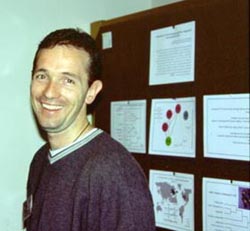
The following month, Mr. Winterton, with other postgraduate students from the University of Queensland Entomology department, traveled for one month through Victoria, South Australia and New South Wales. Collections were made in Wyperfeld, Flinders Ranges, Dutchmans Stern, Warrumbungle and Gammon Ranges National Parks. Approximately 40 species from close to 25 genera were collected during the trip, with greatest diversity in Gammon Ranges and Warrumbungle National Parks.
In September 1998, Shaun attended the International Congress of Dipterology in Oxford, England to present his work on the female reproductive sac. During this trip he also visited various museum throughout Europe and the United Kingdom to examine type specimens. Starting January 1999, Shaun Winterton spent several months in the Wiegmann lab (North Carolina) to work on the molecular systematics of Agapophytus. From there he also attended with the rest of the therevid PEET group, the PEET III conference on Monography at the Smithsonian Institute in Washington, DC, where he presented a poster (right) of part of his work.
Shaun attained his Ph.D. in 2000, and has returned to North Carolina to assume a post-doctoral position and marry.
Longlong Yang
Ph.D. 2000
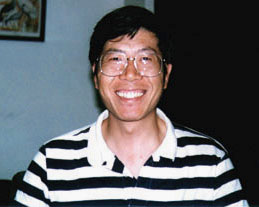
Longlong Yang is a graduate student with Dr. Brian Wiegmann at North Carolina State University. He has a M.S. degree in Entomology from the Institute of Zoology, Chinese Academy of Sciences, with a thesis on systematics of the Tachinidae (Diptera) of Southern China. He also has experience in systematics and biology of Agromyzidae, pollination ecology and behavior of Osmiabees, and species diversity of insects in the tropical rainforests of China.
Longlong began his research assistantship in July, 1996. He is investigating the higher level phylogenetic relationships of the Therevidae using nucleotide sequence data in Brian Wiegmann’s lab at NCSU. He has successfully extracted DNA from several genera and used PCR (polymerase chain reaction) to amplify nuclear and mitochondrial genes for preliminary nucleotide sequence comparisons at the genus level.
Mr. Yang accompanied Mike Irwin, Don Webb, and the other four graduate student dipterists to Guatemala in May 1997. Upon returning to the US, he joined the other students for a week in Illinois at the Irwin lab. While there, all participants reported on their progress on the therevid PEET project. Dr. Irwin presented the phylogenetic relationship of the family Therevidae at subfamily and tribe levels based on morphology. Mr. Shaun Winterton introduced his research on dissection of the internal structure of female terminalia and their phylogenetic significance. Mr. Yang demonstrated the primary phylogenetic relationship of 20 therevid genera and two outgroups using nucleotides of approximately 300 base pairs in length of 28S rDNA. In addition, he labeled all the individuals that were collected by in Guatemala and kept in 95% ethanol for molecular studies. A total of 36 individuals belonging to four genera were identified. Collection records were also input in therevid databases.
Yang also traveled to meetings of the North American Dipterists Society and the Entomological Society of America in 1997. He prepared poster presentations for the NCSU Entomology departmental retreat and the NSF PEET meeting in Woods Hole, MA in 1998. He entered the student paper competition for the Presidents Prize in the Entomological Society of America at the 1999 meeting in Atlanta Georgia, with his talk “Phylogenetics of the stiletto flies (Diptera: Therevidae): Combined evidence from gene sequences and morphology. His Ph.D. thesis entitled: Higher-level Molecular Systematics of the Family Therevidae (Diptera) is nearing completion.
Martin Hauser
M.Sc. 2003
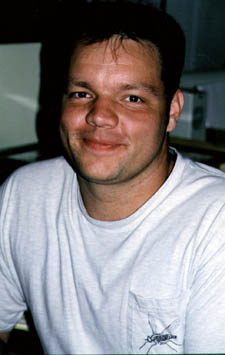
Martin became ‘the 4th musketeer’ in August 1998, joining the UIUC graduate students with the graduation of Steve Gaimari from the program. He came here with the equivalent of a Masters from the Technical University at Darmstadt. He then spent 15 months in a traineeship at the Museum of Natural Science, Stuttgart, Germany. In addition to his native German, he speaks English, French, and has a minor in Latin.
Beginning his graduate studies in the fall of 1998 at the University of Illinois, he took Insect Ecology and a toxicology seminar; he also proficiencied out of the taxonomy and systematics core course in the Dept. of Entomology during that semester. He finished his coursework towards his degree in the spring of 2000, is writing up a paper on the therevid genus Ammonaios to fulfill a departmental masters requirement, and plans to take his preliminary exams in the fall of 2000. He will join Kevin Holston in North Carolina in January 2001 to learn about molecular systematics with Brian Wiegmann.
Before joining the therevid PEET team, Martin already had a flourishing career studying other Diptera, particularly syrphids and stratiomyiids in Germany and all over the world.
Hilary Hill
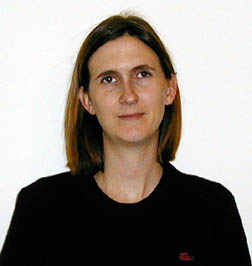
Hilary Hill began her research assistantship and Master’s of Science program in the Entomology Department at North Carolina State University in the fall of 2000. She has just completed her B. S. degree in Biology from Towson University (Baltimore, Maryland) in August of 2000.
While attending Towson University, Hilary became interested in entomology through taking a general entomology course, and then subsequently doing research with Dr. Aubrey Scarbrough . His major research interests are the behavior, ecology and systematics of asilid flies in the New World. During her research with Dr. Scarbrough, Hilary became familiar with the family, and learned quite a bit about the processes involved with systematics and morphological studies.
In the summer of 1999, Hilary spent 10 weeks in the NSF funded Summer Undergraduate Research in Biology Program at Towson University. Her previous research involved re-describing and further clarifying previously described species, describing new species, and constructing keys of asilids from the Oriental-Oceanic region (on loan from the Smithsonian Institution). The research resulted in 2 papers: “Ommatine robberflies (Diptera: Asilidae) from Sri Lanka.”Oriental Insects. 34: 341-407 and “The insula species group of the genus Merodontina Enderlein (Diptera: Asilidae).” Studia Dipterologica (In Press)
Hilary’s Master’s research focuses on the molecular evolution of opsin genes in Therevidae. Her research aims to elucidate the potential for opsin as a marker for phylogenetic studies of higher therevines. Hilary’s interests also include comparisons of the morphological and molecular data in therevids and taxonomy of New World therevid genera.
Christine Lambkin
postdoctoral fellowship CSIRO
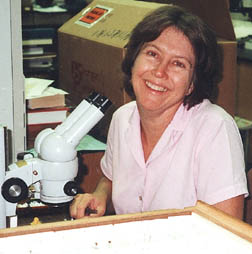
Chris Lambkin joined the therevid PEET team in May 2001 as a Postdoctoral Fellow with David Yeates at the Australian National Insect Collection (ANIC) CSIRO Division of Entomology Canberra to continue the classification of Australian stiletto flies belonging to the Taenogera genus-group. Christine completed her doctorate at the University of Queensland, Brisbane, Australia, with a systematic revision of a tribe of bee flies (Diptera: Bombyliidae), a close relative of the Therevidae in the Asiloidea.
Chris, who has provided some technical assistance to the therevid team in the past, will continue the work on the phylogenetics of the Therevidae concentrating on the genus Ectinorhynchus and its allies, in arid and semiarid environments of Australia (see Australian Expeditions). Part of Chris’s time will be spent investigating the use of web-based dissemination of interactive keys, data, and monographic work. Chris is also investigating the systematic methods that we use in phylogenetic analysis, such as supertree analyses, and is heavily involved in the training and development of scientific knowledge in this area in Australia, America, and Europe.
Christine spent 5 weeks in 2001 in Illinios USA with PI Irwin learning the intricacies of the electronic therevid database MANDALA into which all Australian Therevids will be entered, and to gain understanding of the morphology of the Taenogera-Group (a genus-group of the Therevidae). In Canberra, Chris is able to access MANDALA from the FileMakerPro Server in Illinois through the host seeking capabilities of FileMaker Pro over the internet. She can thus enter data and search records from the live database as if she were at UIUC, limited primarily by internet speeds over such distance. Gail Kampmeier developed a script that allows her to export information from MANDALA via the internet, open it in Microsoft Excel, and with a minimal amount of massaging, enter the data into the CSIRO program BioLink.
A major contribution of our project is training the next generation of systematists. Christine continued this training at PEET IV, June 2002 by coordinating a workshop Character Incongruence between Data Partitions that covered the history of incongruence studies, taxonomic and character congruence, and the prior agreement approach. Hands-on experience was given in assessing incongruence, measuring phylogenetic signal from partitions in combined analysis, partitioned branch support, partitioned hidden branch support, and partitioned character support. At the same conference Chris contributed to the workshop on Morphological Character Analysis by speaking on Missing characters and inapplicables – the ‘?’ state.
Chris also organised an all day Symposium Incongruence, Data Partitions, and Phylogenetic Signal for the Sixth International Congress for Systematic and Evolutionary Biology in Patras, Greece on the 9-16 of September 2002. At this conference Chris spoke on Systematics, evolution, and incongruence: Insights from the World Exoprosopini (Diptera: Bombyliidae) and gave a presentation for Mark Metz For a future in Systematics and the marketability of the discipline: A student perspective on current attitudes and how to prepare for a supply and demand world.
Christine was a member of the local organising committee for the 5th International Congress of Dipterology, in Brisbane Australia 30 Sept-5 Oct 2002, chaired the section on Phylogeny of Cyclorrhapha, and gave 3 presentations:Modern Innovations in Systematic Inquiry; Significant incongruence can be informative: Insights from partitioned support analyses, and The Exoprosopini, Australia and the world: Revelations from systematic studies.
Christine’s work has been acknowledged by the systematic community who voted her into positions as Council Member of the International Organization for Systematic and Evolutionary Biology (IOSEB), 2002-2008, and as Councillor of the Society of Australian Systematic Biologists (SASB).
Chris was interviewed in August 2001 for an Australian-wide radio Media release on therevids titled ‘Jurassic Flies’ that was incorporated into ENN, the Environmental News Network, in Jurassic Flies Survive, Taxonomists face Extinction. Christine was filmed in August 2002 for the Australian-wide television program “Totally Wild” titled Stiletto Flies.
Narelle Power
Bachelor’s Degree with Honors
As part of her Honours thesis for the Bachelor’s at the University of Queensland under Dr. David Yeates, Narelle Power trapped therevid specimens using eleven Malaise traps based in three separate and differing habitats: coastal heath, sclerophyll forest and rainforest. This study revealed that there is a very diverse fauna of Therevidae in the region southeast Queensland. Over 1,000 Therevidae belonging to 15 genera and 52 species were collected throughout a 54 week period. This survey collected a number of closely related species of the genus, Ectinorhynchus, which were the focus of a taxonomic study that included the description of 4 described and 4 undescribed species.
Individual abundance varied across the three sites with 47.5% of specimens collected from sclerophyll forest, coastal heath accounted for 39.2% of the total therevids, and the rainforest site just 13.3%. Individual species appear to be spatially restricted, with site species diversity related to the heterogeneity of the environment.
The majority of therevid species were represented by few individuals, with 10 represented by fewer than 3 individuals. The results of an analysis of seasonal abundance were the most significant findings of the study. Most specimens and all species were taken in spring (September-November). Therefore the most effective sampling for this family in southeastern Queensland should be conducted in spring.
Ms. Power’s thesis work (Long-term Malaise Trapping Study near Brisbane, Australia) represents one of the most extensive and intensive quantitative surveys of Therevidae yet conducted. We now have a much greater knowledge of the form of the therevid bioscape in southeastern Queensland. Narelle is in the process of converting her thesis to a manuscript for publication in the Australian Journal of Entomology.